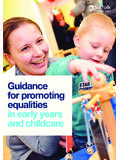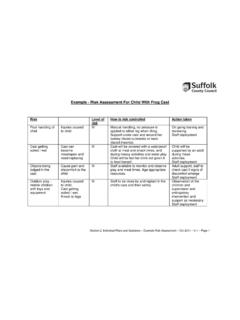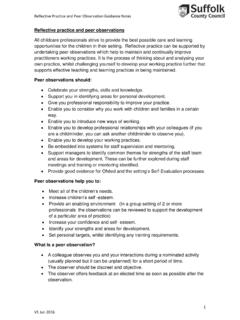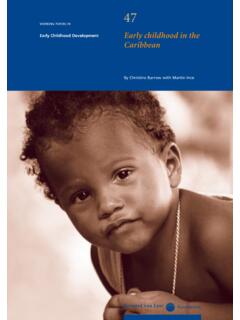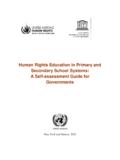Transcription of Safeguarding the Welfare of Children in Early Years and ...
1 - 1 - Safeguarding the Welfare of Children in Early Years and Childcare Settings. A handbook to support the course Introduction to Safeguarding Children Version1: April 2012 - 2 - Contents Introduction Aims and Section One: Good Practice Attitudes, Values and Making Professional Keeping Children Working with Section Two: Roles and Responsibilities The The The Designated The Early Years and Childcare The Suffolk Safeguarding Children Child Exploitation and Online Protection Section Three: Policies and Procedures Safeguarding Children Allegations against The Data Protection Act Information Section Four: Recognising Concerns Indicators of Family issues and Parenting Talking to Children and Young Definitions of Section Five.
2 Recording Concerns and Referral Recording Content of a Record of Flowchart for The Common Assessment Framework for Assessment of References Introduction - 3 - This book is designed as a resource to help you ensure you comply with current guidelines. Its aim is to enhance the learning you have acquired from your Introduction to Safeguarding Children and Young People course. This resource and details of all relevant courses are available on CPD online. Additional information Please note the Suffolk County Council Awareness Raising course available online is designed for those who do not have regular contact with Children and young people. All Early Years and Childcare practitioners in regular contact with Children and young people are required to keep their training up to date.
3 Working Together to Safeguard Children (2010) recommends you refresh the introductory course every three Years . The content is designed to: ensure understanding of the power of assumptions, stereotypes and personal values; develop your understanding of your roles and responsibilities towards Safeguarding Children ; support you in recognising concerns and how to respond to them; ensure you have knowledge and understanding of the legal framework as it affects you as a professional childcare practitioner; ensure you know what you must do if you have evidence that suggests a child may be abused or neglected; ensure you know how to respond appropriately to Children and the adults in their lives about your concerns; and ensure you know how to get support for yourself in carrying out your responsibilities.
4 - 4 - Section One Good Practice Becoming more aware of what Safeguarding Children means in your every day practice. Attitudes, Values and Stereotypes Your attitudes and behaviours will influence the way you relate to Children , their families and colleagues. Children learn from a very Early age how to relate to other people. They learn by imitation and observation (social referencing). It is therefore important that we model desirable values and attitudes to influence their treatment of others or understanding of the world Avoid stereotypes. Children from all sorts of families, environments and life styles may be abused or neglected. Institutions and groups can sometimes deliberately or inadvertently discriminate (institutional discrimination).
5 This is most likely to occur because of workplace policies, procedures or practices that exclude some people and make them feel unwelcome or uncomfortable. It is important to check that this does not apply in your setting. Please refer to EYFS practice guidance about Inclusive Practice and the Equalities Act 2010 Children at a very Early stage of their development develop their sense of self identity and self- esteem. They react to and are influenced by, what goes on and is said around them (attitudes towards their gender, race, culture, lifestyles, attractiveness, intelligence, family members). If a child experiences discrimination and /or abuse it may have a long term damaging affect on their developing identity, feelings of worth and self-esteem. Children are Children First , and all Children need Safeguarding ; only some are in need of protection.
6 - 5 - Making Professional Judgements As an Early Years and Childcare practitioner, you will at times have to make professional judgements about the care, Welfare and protection of the Children in your care; it is important that professional judgements are based on: what you have seen (observed); been told (disclosed) or directly heard a child, young person or parent saying; the facts alone and not your own values, attitudes, assumptions and / or stereotypes; your knowledge of child development and relevant theory; your knowledge of the child and family; your understanding of Safeguarding and indicators of concern Objective Judgements We are helped to make sound objective judgements by: becoming self aware; reflecting upon and evaluating our practice; developing observation, listening and recording skills; exercising non-judgemental and anti-discriminatory practice; ensuring inclusion at all levels including parents as partners; Value your ability to make professional judgements.
7 It is better to refer a concern, even if it turns out to be unfounded, than not to do so and to discover later that a child has been further harmed or neglected. - 6 - Keeping Children Safe Safeguarding Children means keeping Children safe from maltreatment, neglect, violence and sexual exploitation; keeping Children safe from accident, injury and death; knowing how to deal with bullying and discrimination; being safe from crime and anti-social behaviour in and out of the setting; and having security, stability and being cared for. From Early Years : Firm Foundations, 2005 / Children Act 2004: Outcomes Framework: Stay Safe Outcome. In practice this means ensuring we have appropriate knowledge and understanding of: child protection policies and procedures; maintaining health and safety (risk assessment) respecting diversity, equal opportunity and inclusion; partnership with parents; working together for positive behaviour.
8 The Protection of Vulnerable Groups Act 2006 We must: always work in an open and transparent manner; build balanced relationships; ensure any manual or physical support is provided openly and in accordance with National guidance; treat all Children , young people and vulnerable adults with respect and dignity. - 7 - We must never: use physical force against an individual unless it constitutes reasonable restraint to protect the child, some other child, person or property; engage in rough, physical or sexually provocative games; allow or engage in any form of sexual touching; allow Children to use inappropriate language unchallenged; make sexually suggestive comments to a child or vulnerable adult even in fun; reduce a child, young person or vulnerable adult to tears as a form of control; allow allegations made by Children , young people or vulnerable adults to go unchallenged, unrecorded or not acted upon; do things of a personal nature for Children , young people or vulnerable adults that they can do for themselves.
9 Invite or allow Children , young people or vulnerable adults to stay with you at your home unsupervised (unless you are registered to do so ( home based carers: childminder, foster carer, respite carer). Practice to be avoided: spending significant amounts of time alone with Children away from others; taking Children to your home where they can be alone with you; giving lifts alone in your car; having parents/carers as friends on social networking sites or use personal mobile phones to contact them. The above may not apply to registered home based carers such as childminders. However such practitioners need to be mindful of good lone worker practices and ensure their policies reflect how they deal with the above. - 8 - Beware Avoidance Doing something about our concerns is not always easy and there is a temptation to avoid the issue, perhaps without realising that we are doing so: this does not safeguard Children .)
10 Failure to pass on concerns may allow the situation to deteriorate Unfortunately there are no pain free ways of dealing with concerns. Do not delay or keep quiet because you fear getting it wrong, or that you are being over sensitive; Seek support from your designated Safeguarding person and/or speak informally to The Access Team via Customer First. Dealing with our Emotions Each of us will respond differently to situations we find ourselves in and each of us has to find the best way to deal with how we feel. It is likely that you will be affected emotionally by the abuse of Children . However it can be made easier if we know where we can get support; know the correct procedures to follow; understand ourselves and have some stress busting techniques at hand; don t become over familiar with parents; and maintain a professional relationship with them; it is part of our professional role to keep Children safe from actual and potential abuse/neglect.
